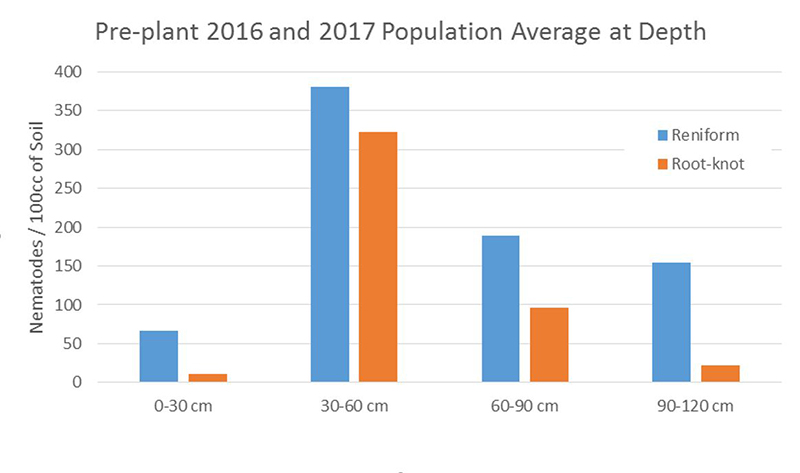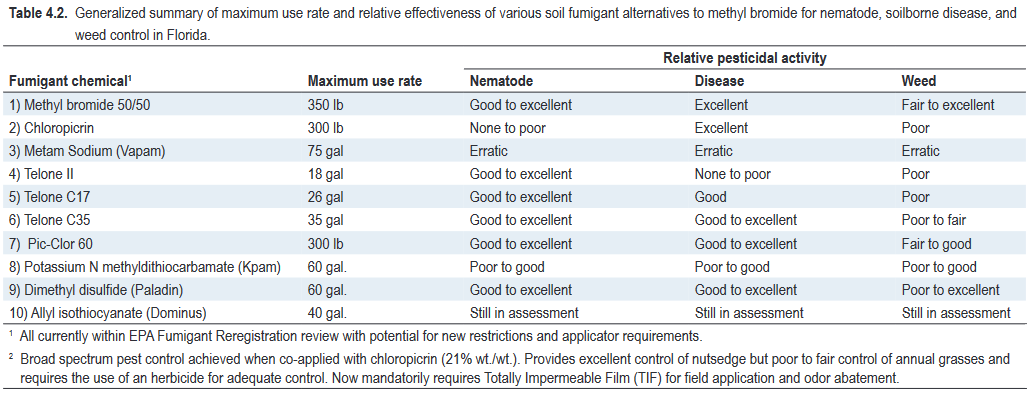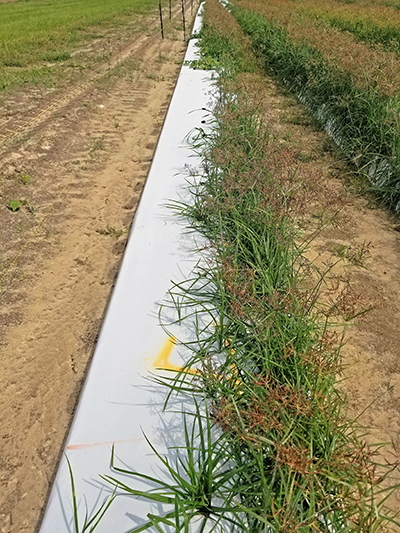Most vegetable and melon producers in this region have some history with using soil fumigation, whether Telone (1,3-dichloropropene) for nematode control in peanuts or cotton, methyl bromide and chloropicrin for weed and disease control in tomatoes, or Vapam (metam sodium) for weed control in watermelon. Soil fumigants are volatile pesticides that are applied to the soil before planting as liquids and subsequently volatilize to gas and move through soil pore space. Many are broad spectrum biocides and have activity on weed seeds, nematodes, fungi, and bacteria. If used properly fumigants can be a highly effective pest management tool. Though most fumigants have some efficacy on many pests they often are more effective on one than another.
Historically, methyl bromide was used because it moved rapidly through soil, often far from the site of injection. This ability, combined with its’ broad toxicity, is what made methyl bromide such an effective fumigant. With methyl bromide no longer available, selecting the right fumigant and application method is more challenging. Most of us have heard the saying “don’t bring a knife to a gun fight” and have a good understanding what it means. The thought behind this statement applies well to the choice of a currently available soil fumigants and the application method used to deliver them. If the proper choice of soil fumigant and application method are not made, we may as well be bringing a knife to our gun fight with nematodes, disease, and weeds.
In addition to pest specificity, fumigant movement in the soil is a major limiting factor to the efficacy of currently available fumigants. A summary of soil fumigant strengths and weaknesses can be found in table 4.2 in Chapter 4 of the Vegetable Production Handbook of Florida.
This article is intended to serve as a primer for producers considering soil fumigation for the 2020 growing season. I would like to present three major points to consider when choosing a soil fumigant and an application method.
1 – Pest to be managed and where it is found in the soil profile
Producers must understand which pests are yield limiting in their circumstance. This can often be location and crop specific. These factors should be considered in the overall integrated pest management strategy which should include varietal resistance, crop rotation, and chemical control. Nematodes may be a problem in one location while weed pressure is most important in another. Most weeds arise from the top 4” or less of the soil profile while recent work has demonstrated that nematode populations may be up to 3’ deep prior to planting (Table 1). Because of the difference in pest location a single fumigation strategy may not be appropriate for all locations. To effectively manage multiple pests it is often appropriate to target the application of the fumigant to the location of the pests. This could be deep shank application, shallow coulter, drip application, or a combination of these.
 Table 1. Location of Reniform and Root-knot nematodes in the soil profile prior to seeding during the spring season in North Florida.
Table 1. Location of Reniform and Root-knot nematodes in the soil profile prior to seeding during the spring season in North Florida.
–
2 – Strengths of the fumigant to be used
Table 4.2 below goes over the strengths of available fumigants on common pests and should be taken into consideration, along with consultation with local and state specialists, when choosing which fumigant to use. Because many have weaknesses on certain pests it may be appropriate to use a combination of soil fumigants to broaden the pest control spectrum. Fumigant ratios can be adjusted accordingly to address pests of concern. Fumigant mobility in the soil may be limited so it may be appropriate to change the application strategy to physically overcome some of these issues.
–
3 – Application method needed to bring the fumigant into contact with pests
Points 1 and 2 have touched on bringing the fumigant and pest together, but this point must be stressed because it is often the cause of control “failures”, which are really the failure of the fumigant to be close to the pests. Figure 1 is an example of a fumigant being effective against a given pest, but lacking the ability to reach the entire area needing treatment. This fumigant was drip applied and did an excellent job of controlling nutsedge close to the drip tape, but failing to control on the side opposite of the drip tape. Current fumigants simply do not move extensively in the soil, so it would be difficult for Telone applied 6” deep to reach and control nematode population that is 24” deep. It would also be inappropriate to deep shank Vapam at 18” and expect it to control weeds. These are merely examples, but they illustrate the point of why fumigants can underperform if they are not used appropriately.
Bottom Line
Fumigants can be a highly effective pest management tool in many different cropping systems, but they are not without their limitations. Currently available fumigants are simply not as effective and forgiving as methyl bromide was, so more information must go into the process of deciding which fumigant or fumigants to use, and how to apply those to adequately control pest populations in a site-specific manner.
- NFREC Faculty Tribute to Arnie Forrester - February 11, 2022
- Tomato Varieties for 2022 - January 28, 2022
- Pumpkin Production in North Florida - July 30, 2021


